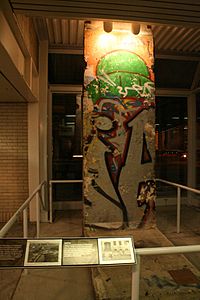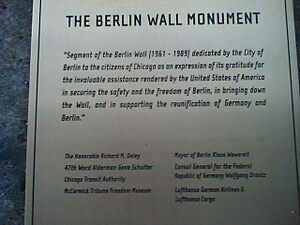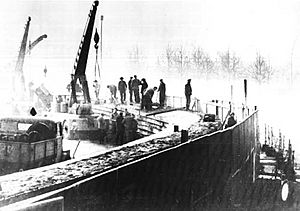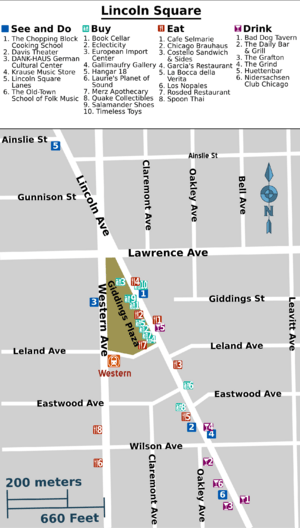Berlin Wall Monument (Chicago) facts for kids

The Berlin Wall Monument in Chicago, showing the side that faced West Germany
|
|
| Coordinates | 41°57′58″N 87°41′19″W / 41.966165°N 87.688513°W |
|---|---|
| Location | Lincoln Square, Chicago |
| Type | Wall fragment |
| Material | Concrete |
The Berlin Wall Monument in Chicago is a special display. You can find it at the Western Brown Line CTA train station. This monument has a large piece of the actual Berlin Wall. It also has a plaque that explains why it was given to Chicago. The Berlin Wall was a huge symbol. It showed the big differences between two powerful groups in the 1900s: the United States and the Soviet Union.
What Was the Berlin Wall?
See Also: World War II, The Cold War, Berlin Wall
World War II greatly impacted many countries, especially Germany. After years of fighting, Nazi Germany gave up to the Allied countries in 1945. Later, the Empire of Japan also surrendered.
After the war, new problems arose between two of the winning countries: the United States and the Soviet Union. The United States believed in capitalism, where people own businesses. The Soviet Union believed in communism, where the government controls everything. Germany was right in the middle of this disagreement. Its capital city, Berlin, was divided by the winning countries. There was a capitalist side and a communist side.
About two decades later, in 1961, a huge wall was built. This was the Berlin Wall. It was 96 miles long. It made the division between the two sides even stronger. The wall showed the big political and economic differences between the United States and the Soviet Union. This conflict, known as the Cold War, affected the whole world, especially Germany. Even after the wall was taken down, it remained a symbol of these divisions.
After the Wall Fell

The Berlin Wall fell on November 9, 1989. After this, pieces of the wall were given to many cities around the world. In 2008, the German government offered a piece of the wall to Chicago. It was placed in the Lincoln Square neighborhood. This area has strong German roots. The wall piece is now on permanent display at the Western Brown Line Station. Lincoln Square is in the northern part of Chicago.
The specific piece of the wall given to Chicago was from the fourth stage of the wall's construction. This part was called Grenzmauer 75.
A special event was held to dedicate the monument. About 120 people attended. Important guests included Chicago Mayor Richard M. Daley and the German diplomat to the U.S., James D. Bindenagel. This is one of two pieces of the Berlin Wall on display in Illinois. The other piece is at Eureka College in Eureka, Illinois.
What the Monument Looks Like
The Berlin Wall monument in Chicago can be seen from both sides. The side that originally faced West Germany has graffiti and messages. These were sprayed on the wall when it was still standing. The side that faced East Germany, however, is completely blank.
It is easy to tell the two sides apart. The side with graffiti was the "free side." People there could express themselves. Nicholle Dombrowski, from the DANK Haus German American Cultural Center, explained this. She said the west side had graffiti because people were free to do things. The east side was clean because people lived under a communist government. They were not allowed to express themselves. This piece of the wall shows the two very different sides of a long and difficult conflict.
The monument also has a plaque. It explains why the wall fragment was donated. The inscription says:
- "Segment of the Berlin Wall (1961 - 1989) dedicated by the City of Berlin to the citizens of Chicago as an expression of its gratitude for the invaluable assistance rendered by the United States of America in securing the safety and freedom of Berlin, in bringing down the Wall, and in supporting reunification of Germany and Berlin."
The plaque also lists important people and groups. These include Chicago Mayor Richard M. Daley, Mayor of Berlin Klaus Wowereit, the German Consul General Wolfgang Droutz, Lufthansa, and the Chicago Transit Authority.



